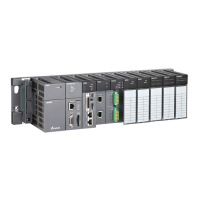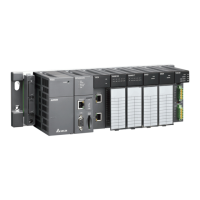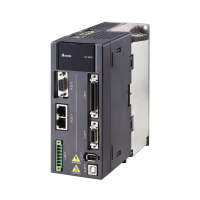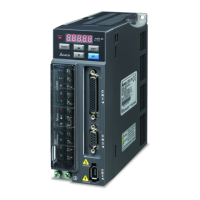Chapter 2 Devices
2-11
The input number (the decimal number):
For the PLC, the input numbers start from X0.0. The number of inputs varies with the number
of inputs on the digital input/output modules, and the inputs are numbered according to the
order in which the digital input/output modules are connected to the CPU module. The
maximum number of inputs on the PLC can reach up to 8192, and the range is between X0.0
and X511.15.
The input type
The inputs are classified into two types.
1. Regenerated input: Before the program is executed, the data is fed into the PLC
according to the states of the inputs which are regenerated. For
example, LD X0.0.
2. Direct input: During the execution of the instructions, the data is fed into the PLC
according to the states of the inputs. For example, LD DX0.0.
2.2.5 Output Relays
The function of the output
The task of the output is sending the ON/OFF signal to drive the load connected to the output.
The load can be an external signal lamp, a digital display, or an electromagnetic valve. There
are three types of outputs. They are relays, transistors, and TRIACs (AC thyristors). Contact A
or contact B of the output can be used several times in the program, but the output should be
used only once in the program. Otherwise, according the program-scanning principle of the
PLC, the state of the output depends on the circuit connected to the last output in the program.
The output number (the decimal number)
For the PLC, the input numbers start from X0.0. The number of outputs varies with the number
of outputs on the digital input/output modules, and the outputs are numbered according to the
order in which the digital input/output modules are connected to the PLC. The maximum
number of outputs on the PLC can reach up to 8192, and the range is between Y0.0 and
Y511.15.
The output which is not practically put to use can be used as a general device.
The output type
The outputs are classified into two types.
1. Regenerated output: Not until the program executes the instruction END is the
information fed out according to the states of the outputs. For
example, OUT Y0.0.
2. Direct output: When the instructions are executed, the information is fed out according to
the states of the outputs. For example, OUT DY0.0.
2.2.6 Auxiliary Relays
The auxiliary relay has contact A and contact B. It can be used several times in the program. Users
can combine the control loops by means of the auxiliary relay, but can not drive the external load by
means of the auxiliary relay. The auxiliary relays can be divided into two types according to their
attributes.
1. For general use: If an electric power cut occurs when the PLC is running, the auxiliary relay for
general use will be reset to OFF. When the power supply is restored, the
auxiliary relay for general use is still OFF.
2. For latched use: If an electric power cut occurs when the PLC is running, the state of the
auxiliary relay for latched use will be retained. When the power supply is
restored, the state remains the same as that before the power electric cut.

